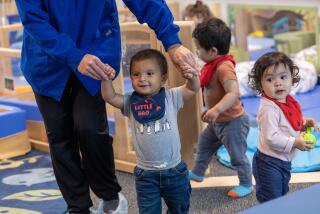Eastin Calls for Preschool for All Children
Surrounded by children washing dolls, climbing on stacks of blocks and playing on a grassy hill, state Supt. of Public Instruction Delaine Eastin on Monday launched an ambitious campaign to make preschool available for all Californiaâs 3- and 4-year-olds.
Eastin used her visit to a highly regarded Westwood preschool--one that serves the children of UCLA students, staff and faculty members--to announce formation of a 55-member task force to study how to implement such a plan.
Pointing to the UCLA youngsters, Eastin called for a âsecure, lifelong investment in these children,â predicting that it would produce a rich payoff--more high school graduates, less truancy, fewer teenage pregnancies and greater student achievement.
âThe return on this investment is at least 7 to 1,â she said. âItâs important we make preschools like this one available for everyone.â
But coming up with the money to essentially add 1 million children to the stateâs preschool enrollment over the next five years would be difficult, economically as well as politically.
Though Eastin did not say what her plan would cost, estimates prepared by Gov. Pete Wilsonâs Office of Child Development and Education show that providing half a day of preschool instruction for all California 3- and 4-year-olds would carry a price tag of $2.5 billion to $3 billion annually.
Eastin said federal funds and a growing California economy could provide a lot of that money. But dollars that would otherwise flow to existing programs for kindergarten through grade 12 would have to be diverted to the new program. And instead of targeting the poor, as do the stateâs current preschool and child-care programs, universal preschool would benefit the middle class and even the wealthy.
Under one scenario offered by an aide to Eastin, for example, the state would begin subsidizing the costs of existing, private for-profit preschools.
Nonetheless, the proposal is likely to be popular, especially among working parents who have struggled to pay for preschool, which can cost $800 or more a month, or who have been unable to find slots available.
Bolstering the argument for making preschool more accessible is a growing body of research on the brain showing that phenomenal growth and development occurs far earlier than had been recognized. That means very young children benefit greatly from a wide range of stimulating experiences, especially being spoken to, reciting nursery rhymes and playing with the sounds of words.
Another factor is the nationwide push to move parents off welfare rolls and into the world of work. The families of 2.6 million children in California would be eligible for subsidized child care as a result of welfare reform in California.
Whatâs more, preschools--and the advantages they bring to children--now benefit some groups more than others. A report due out this week from educational policy researchers based at UC Berkeley found that the availability of child care and preschool depends heavily on income.
The shortages are greatest in Latino neighborhoods, where the supply is about half that in white or African American neighborhoods.
The researchers found that the shortages were particularly severe in Los Angeles County, where white communities have more than 2.5 times as many preschool and day-care slots per child as predominantly Latino communities.
Those gaps persist even though the amount spent by the state on preschools and child care has increased dramatically, from $325 million to $1.2 billion in the past decade.
âThereâs an enormous need to equalize these gaps in access, but if we do that rapidly, itâs pretty easy to predict that overall quality will decline,â said Bruce Fuller, a director of Policy Analysis for California Education, which produced the report.
Eastin said she hopes to have legislation ready for the Legislature by January. But even if the plan won political approval--a longshot considering the costs--implementing it would not be easy.
âBuildings need to be built, labor needs to be trained, a bureaucracy needs to be organized, computer programs need to be written,â said Karen Hill-Scott, the founder of a private nonprofit child development organization in South-Central Los Angeles and the co-chair of Eastinâs child care task force. âItâs a huge undertaking.â
Indeed, it would take some doing to create a supply of schools the quality of the Bellagio Child Care Center at UCLA, where Eastin spoke.
Set on a shady hillside with wide patios and sunny rooms, the school has a very favorable ratio of teachers to children--five teachers for 18 infants, for instance. The older children are taught to sing in Chinese and Spanish as well as English. Mozart is played in the background while children paint pictures.
That doesnât mean the teachers actually teach, however. There are no letters or numbers to be seen in the 4-year-oldsâ room--âWe donât do that because itâs inappropriate at this stage,â said the centerâs director, Susan Wood.
More to Read
Sign up for Essential California
The most important California stories and recommendations in your inbox every morning.
You may occasionally receive promotional content from the Los Angeles Times.










